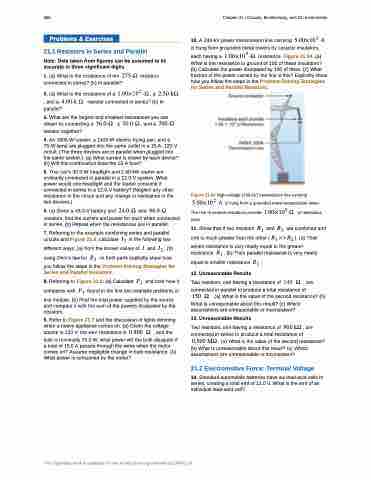Page 978 - College Physics For AP Courses
P. 978
966
Chapter 21 | Circuits, Bioelectricity, and DC Instruments
Problems & Exercises
21.1 Resistors in Series and Parallel
Note: Data taken from figures can be assumed to be accurate to three significant digits.
1. (a) What is the resistance of ten ����� resistors connected in series? (b) In parallel?
2. (a) What is the resistance of a �������� �� , a ������� , and a ������ � resistor connected in series? (b) In parallel?
3. What are the largest and smallest resistances you can obtain by connecting a ������ , a ������ , and a ����� resistor together?
4. An 1800-W toaster, a 1400-W electric frying pan, and a 75-W lamp are plugged into the same outlet in a 15-A, 120-V circuit. (The three devices are in parallel when plugged into the same socket.). (a) What current is drawn by each device? (b) Will this combination blow the 15-A fuse?
5. Your car’s 30.0-W headlight and 2.40-kW starter are ordinarily connected in parallel in a 12.0-V system. What power would one headlight and the starter consume if connected in series to a 12.0-V battery? (Neglect any other resistance in the circuit and any change in resistance in the two devices.)
6. (a) Given a 48.0-V battery and ������ and ������ resistors, find the current and power for each when connected
in series. (b) Repeat when the resistances are in parallel. 7. Referring to the example combining series and parallel
circuits and Figure 21.6, calculate �� in the following two
different ways: (a) from the known values of � and �� ; (b)
using Ohm’s law for �� . In both parts explicitly show how
you follow the steps in the Problem-Solving Strategies for Series and Parallel Resistors.
8. Referring to Figure 21.6: (a) Calculate �� and note how it
compares with �� found in the first two example problems in
this module. (b) Find the total power supplied by the source and compare it with the sum of the powers dissipated by the resistors.
9. Refer to Figure 21.7 and the discussion of lights dimming when a heavy appliance comes on. (a) Given the voltage source is 120 V, the wire resistance is ����� � , and the bulb is nominally 75.0 W, what power will the bulb dissipate if a total of 15.0 A passes through the wires when the motor comes on? Assume negligible change in bulb resistance. (b) What power is consumed by the motor?
10. A 240-kV power transmission line carrying �������� � is hung from grounded metal towers by ceramic insulators, each having a �������� �� resistance. Figure 21.54. (a)
What is the resistance to ground of 100 of these insulators? (b) Calculate the power dissipated by 100 of them. (c) What fraction of the power carried by the line is this? Explicitly show how you follow the steps in the Problem-Solving Strategies for Series and Parallel Resistors.
Figure 21.54 High-voltage (240-kV) transmission line carrying �������� � is hung from a grounded metal transmission tower.
The row of ceramic insulators provide �������� � of resistance each.
11. Show that if two resistors �� and �� are combined and one is much greater than the other ( � ��� ): (a) Their
This OpenStax book is available for free at http://cnx.org/content/col11844/1.14
series resistance is very nearly equal to the greater resistance �� . (b) Their parallel resistance is very nearly
equal to smaller resistance �� . 12. Unreasonable Results
Two resistors, one having a resistance of ��� � , are connected in parallel to produce a total resistance of
��� � . (a) What is the value of the second resistance? (b) What is unreasonable about this result? (c) Which
assumptions are unreasonable or inconsistent?
13. Unreasonable Results
Two resistors, one having a resistance of ��� �� , are connected in series to produce a total resistance of
����� �� . (a) What is the value of the second resistance? (b) What is unreasonable about this result? (c) Which
assumptions are unreasonable or inconsistent?
21.2 Electromotive Force: Terminal Voltage
14. Standard automobile batteries have six lead-acid cells in series, creating a total emf of 12.0 V. What is the emf of an individual lead-acid cell?
��


